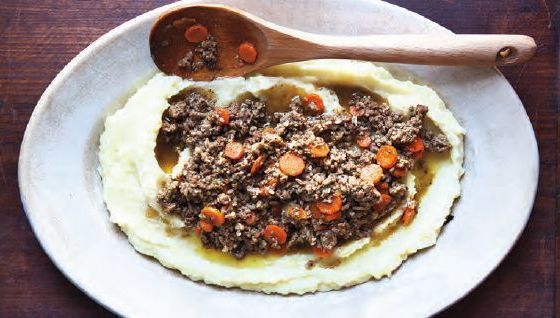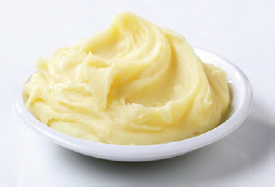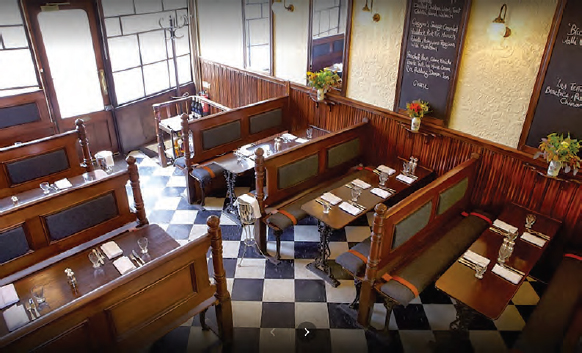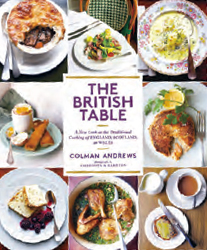
Mince and tatties! A sure fire Scottish favorite.
Back in fashion nowadays but with its history dating back hundreds of years, this Scottish homely meal is still a favourite.
While researching his cookbook, James Beard Award-winning food writer Colman Andrews was surprised by the delicious meals enjoyed on the Sceptered Isle during centuries past. “I found out people actually ate really well in the 17th, 18th and 19th centuries—not just in England but also in Scotland and Wales,” says the author of The British Table.
“You could say it was the upper classes, but also the rural population ate well. They didn’t have the same foods, but they grew a lot of their own produce, raised their own animals. It was plentiful, fairly simply cooked and, apparently, very good.”
An Anglophile who’s been traveling to the UK for more than 50 years, Andrews has watched the restaurant culture evolve dramatically, and deliciously, over the last few decades.
“Like everyone else, I had a pretty bad reaction in the early days. Unless you were eating Indian food in London, there weren’t a whole lot of good choices.”
Luckily, over the last 25 years he’s witnessed a reclamation of the great British culinary heritage. “It’s about food that’s more attuned to the historical cooking of the island,” he adds in his distinctly American accent.
“Chefs are increasingly reviving old dishes. Restaurants are really going back to the days where you’d have basic ingredients and not do too much to them. Put them on the plate and let them speak for themselves! Cooking that’s not terribly complicated, but really flavorful.”
These traditional dishes are the ones Andrews looks forward to the most when visiting now.
It’s really great to walk into a restaurant and see there’s venison pie on the menu, or they have chicken stuffed with haggis—or, for example, mince and tatties.”
Andrews shares his favorite version of that classic with BHT. “The recipe that appears in my book is actually a Scottish one, so it includes a few extra things, like a scattering of oats and a little blood sausage for flavor.”
He calls it quintessential home cooking: “The kind of thing the housewife in the old days would make for when everyone came home from work. Simple yet very satisfying!”
Mince and tatties recipe
• 4 servings
Ingredients
1 tablespoon stone-ground Scottish oats
2 tablespoons corn or canola oil
1 large onion, finely chopped
1 pound (450 g) ground beef
1 large carrot, thinly sliced
1 (4 ounce/115 g) black pudding, skin
removed (optional)
Salt and freshly ground black pepper
Mashed potatoes
Method
Toast the oats in a small dry skillet over medium-high heat, shaking the pan frequently, until they turn golden brown, 4 to 6 minutes. Set aside.
Heat the oil in a large skillet over medium heat. Add the onion and cook, stirring frequently, until it browns, 10 to 12 minutes. Push it to one side of the skillet, then add the ground beef.
Cook the beef, breaking it up into small pieces with a wooden spoon as it cooks until it is well browned, stirring it frequently and mixing in the onions when the beef begins to change color, 12 to 15 minutes.
Add the carrot and the toasted oats, stirring them in well, then add the black pudding (if using), breaking it up with a wooden spoon so that it mixes well with the beef. Add enough water to cover the ingredients, then season the mince generously with salt and pepper, reduce the heat to low and simmer for about 15 minutes, or until the carrots are soft. The finished mince should have the consistency of a thick stew. Serve with mashed potatoes on the side.

Perfect Mashed Potatoes (Tatties)
• 4 Servings
Ingredients
5 to 6 medium potatoes (about 2 pounds/900g), unpeeled, scrubbed
1 cup (240 ml) heavy cream
6 to 8 tablespoons (3/4 to 1 stick/85 to
115g) butter, softened
Salt and pepper
Method
Put the potatoes into a pot large enough to hold them in a single layer and fill the pot halfway with cold water. Cover the pot and bring water to a boil over high heat. When the water begins to boil, carefully drain off all but about 1/2 inch (1.25 cm) of it, then return the pot to the heat, cover, reduce the heat to low and let the potatoes steam until tender, about 40 minutes. Add a little more water as the pot begins to go dry. Reserve 2 tablespoons of the cooking water, then transfer the potatoes to a bowl, cover them with a clean dish towel and set them aside for 15 minutes to cool slightly.
Meanwhile, put the cream, butter, and reserved cooking water into a small pot and bring the mixture to a simmer over medium-high heat, then reduce the heat to low and simmer until the potatoes have cooled.
Drain and carefully slip the peels off the mashed potatoes, then return them to the large pot and mash them well while slowly pouring in the cream mixture. Generously season the potatoes with salt and pepper, then whisk them vigorously with a large whisk to dissolve any big lumps (potatoes will not be completely smooth).
Looking for a place to order it? Andrews suggests London’s Quality Chophouse

“It’s an old working man’s café that has a small menu, but very honest, straightforward, good food. This is one of their star dishes that’s always on the menu, but I think they call it ‘Mince and Mash.’ I don’t think they use ‘tatties’ since that’s a Scottish word, but it’s the same idea, really.” thequalitychophouse.com

The British Table: A New Look at the Traditional Cooking of England, Scotland, and Wales by Colman Andrews ($50, Abrams) is available now.
* Originally published in June 2017.





Comments